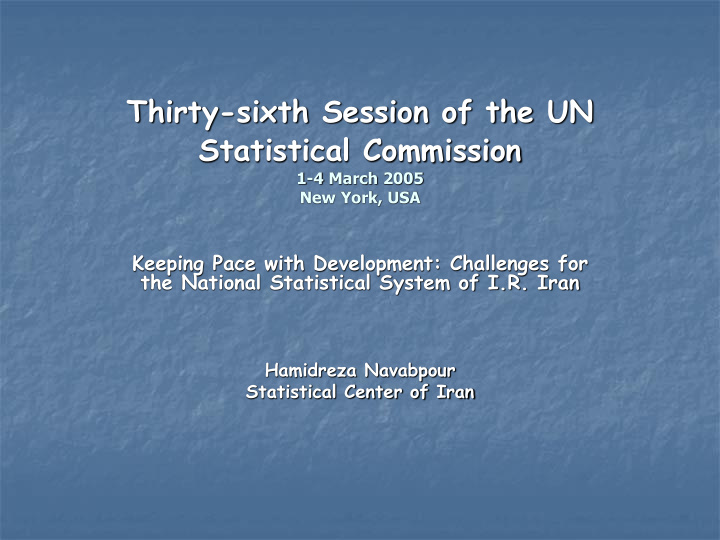



Thirty-sixth Session of the UN Statistical Commission 1-4 March 2005 New York, USA Keeping Pace with Development: Challenges for the National Statistical System of I.R. Iran Hamidreza Navabpour Statistical Center of Iran
Introduction The latest statistical Law in Iran dates back to 1975. Based on the 1975 Law, the statistical system of Iran is centralized, led by the Statistical Center of Iran (SCI). The SCI is affiliated to the Management and Planning Organization (MPO) which is headed by a Vice President. Therefore, the President indirectly supervises the National Statistical System (NSS). According to the Law, the statistical system of Iran is illustrated by the following chart.
Organizational Chart of the National Statistical System President Management and Planning Organization Government High Council of Statistical Research Statistical Center of Iran Agencies Statistics Center Expert Advisory Specialized Committee Council Commission Deputies of the SCI Director Generals of the SCI 30 Provincial Offices
Statistical Center of Iran Within the system, the SCI is indirectly connected to other government agencies ( through the High Council of Statistics). The nominee for presiding SCI is proposed to the President by the Head of the MPO. When accepted, the nominated person will be appointed as the Head of the SCI for an indefinite period.
Main duties of the SCI Implementation of demographic, economic, and social censuses and sample surveys and dissemination of results; Provision of statistical data to meet national development planning requirements; Provision of technical advice to statistical departments of ministries, government agencies and/or government affiliated bodies, state-owned companies, and – whenever possible – to private sector agencies; Preparation and compilation of standards, methods, and regulations for statistical data production and dissemination; Implementation of scientific studies and researches on official statistics and related issues for quality improvement of the SCI's performance; and Compilation of required statistical data obtained from public and private sectors and centralized documentation of administrative records.
High Council of Statistics (HCS) The HCS is composed of deputies for planning of 10 Ministries and Central Bank. Head of the MPO is Head of the HCS and its secretary is the Head of the SCI. Main duties of the HCS: Studying short- and mid-term plans of the NSS; Studying statistical production priorities of the NSS; and Studying national statistical plans to ensure their compliance with the general policies and statistical priorities . The approvals of the HCS are mandatory for government agencies and they are bound to follow them.
Advisory Council Advisory Council in the SCI is composed of survey statisticians and academics in economics, demography and IT. The Council is responsible for reviewing all existing procedures and providing rectifying comments aimed at their improvement as well as presenting consultative comments on procedures in case of the SCI’s Head request.
Expert Committee Expert Committee is composed of the SCI’s young experts from different departments in order to study official statistics. When they find something new and useful they implement a feasibility study. When they find the case feasible, the case will be referred (by the Head) to the responsible department for planning and implementation.
Statistical Research Center Statistical Research Center is affiliated to the SCI. The Center is responsible for statistical capacity building of the NSS through: Conducting workshops and short-training courses on official statistics Implementing researches on official statistics
Challenges for the NSS (1) The tenure of the Head of the SCI is not specified, therefore the preparation and fulfillment of mid and long-term statistical plans, such as National Strategy for the Development of Statistics (NSDS), looks a challenging task. Statistical literacy and culture: - Some of respondents are less aware of the applications of the statistical data, consequently, they sometimes show little interest to fully cooperate in the surveys. - Evidence-based management is not so widely applied, therefore, the demand for the statistical data and their applications are limited and insufficient. The legal restrictions on the increase of the manpower of the government has forced the Center to turn to the private sector for collecting and entry of the statistical data. This outsourcing presents challenges with regard to data confidentiality and quality.
Challenges for the NSS (2) Private sector in Iran is not capable of meeting the national requirements for official statistics. There is no statistical field of study with special reference to official statistics in Iranian universities; hence, it seems necessary for the graduates in statistical disciplines to receive some pre-service trainings on official statistics after their recruitment in the NSS. The Central Bank of the I.R. Iran independently produces statistics, such as national accounts and price indices, while, according to the Statistical Law, the SCI is assigned to produce them. Absence of the experienced statistical departments in the government agencies has caused calculation of the MDGs indicators to face challenges. It is noteworthy that out of 48 indicators of the MDGs, 36 indicators are applicable to Iran of which 20 indicators are completely or partially calculated by the SCI. Absence of a register-based statistical system for production of required statistics has led to too much reliance on the surveys.
What have we done to overcome these challenges? Preparing an NSDS: At the beginning of the work, 9 working groups were formed and each group studied the existing situation in its own field of work and prepared a vision for a better situation. Each of them developed a strategic plan.
Nine Working Groups are: Information Technology (IT) Development 1. Statistical Data Production 2. The Organization of the Foundations of Statistical System 3. Manpower 4. Statistical Research 5. Improved Data Quality 6. Statistical Standards 7. Promotion of Statistical Literacy and Culture 8. Register-based Statistics 9.
Outputs Assessment of the current situations Visions Strategic plans What do we need to do? Action plans Implementation Monitoring and evaluation
Recommend
More recommend